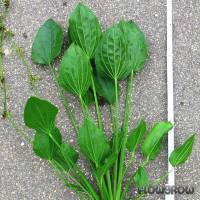



Echinodorus palaefolius is often offered in trade, however, it is not often sold under its real name.
A rather acuminately-tipped form quite similar to E. subalatus (fig. 3-5) is called "E. argentinensis" in trade, however, it has nothing in common with true E. argentinensis, which belongs to the E. grandiflorus complex and cannot be found in trade any more (for further information, please see Echinodorus grandiflorus).
Another form often sold under the trade name "Echinodorus rigidifolius" (which is not a valid botanical name) has wide ovate leaves and bulges at the upper end of the leaf stalk (see fig. 1 and 2). The same form, or one very similar to it, is also traded under the name E. palaefolius var. latifolius.
E. palaefolius originates from eastern Brazil and grows as a bog plant in nature. It is closely related to E. subalatus, and has leaf stalks with longitudinal ridges and a distinct groove on the upperside like the latter. Its leaves are relatively small (2 to 2.5 cm) with 12 pale yellow stamina and relatively narrow petals. The margins of the axis of the flower stalk is alate in both species. E. palaefolius differs from E. subalatus by wider emersed leaf blades, amongst others, which are less than twice as long as wide.
This sword plant might be confused with E. cordifolius, however, the latter has larger flowers (2.5 to 3 cm) with 15 to 26 stamina, no groove on the upper side of the leaf stalk, and its flower stalk axis is not alate.
The submersed leaves of E. palaefolius are lanceolate, much like those of E. subalatus, under good lighting the new leaves may show a reddish tint, and the leaves have a relatively long stalk.
This species may be quite undemanding and grow rather fast, however, its aquarium use is milited by its tendency to grow aerial leaves above the waterline once it has grown to a strong plant. This may be circumvented for some time by the removal of the leaves with the longest stalks, which causes the plant to sprout shorter-stalked leaves for some time - or by replacing the adult plant with a young one. However, E. palaefolius is best suited for open tanks as an emersed solitary plant, or for large paludaria, where it may reach an overall height of about 1 metre, developing a large amount of leaves as well as its ramifying flower stalks with its typical, rather small flowers. These flower stalks grow upright in the beginning and start curving downwards later on, sprouting many adventitious plants.
<a href="https://www.flowgrow.de/db/aquaticplants/echinodorus-palifolius" target="_blank"><img alt="Echinodorus palifolius" title="Echinodorus palifolius" src="https://www.flowgrow.de/db/widget/aquaticplants/echinodorus-palifolius" /></a>
[url=https://www.flowgrow.de/db/aquaticplants/echinodorus-palifolius][img]https://www.flowgrow.de/db/widget/aquaticplants/echinodorus-palifolius[/img][/url]
[widget=aquaticplants/echinodorus-palifolius]Echinodorus palifolius[/widget]